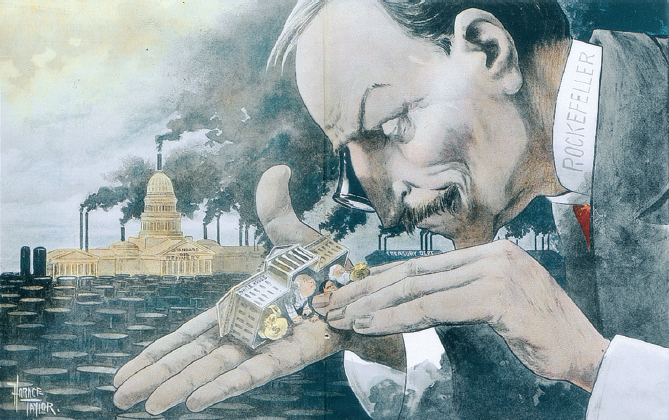How did the railroads stimulate big business?
Printed Page 518

CHRONOLOGY
1869
- – First transcontinental railroad is completed.
1870
- – John D. Rockefeller incorporates Standard Oil Company.
1872
- – Andrew Carnegie builds world’s largest steel plant.
1876
- – Alexander Graham Bell demonstrates the telephone.
1882
- – John D. Rockefeller develops the trust.
IN THE YEARS following the Civil War, the American economy underwent a transformation. Where once wealth had been measured in tangible assets — property, livestock, buildings — the economy now ran on money and the new devices of business — paper currency, securities, and anonymous corporate entities. Wall Street, the heart of the country’s financial system, increasingly affected Main Street. The scale and scope of American industry expanded dramatically. Old industries like iron transformed into modern industries typified by the behemoth U.S. Steel. Discovery and invention stimulated new industries, from oil refining to electric light and power. The reckless expansion of the railroad in the decades after the Civil War played the key role in the transformation of the American economy.
Jay Gould, Andrew Carnegie, John D. Rockefeller, and other business leaders pioneered new strategies to seize markets and consolidate power. Always with an eye to making the most of their opportunities, these tycoons set the tone in the get-rich-quick era of freewheeling capitalism that came to be called the Gilded Age.
Gilded Age
 A period of enormous economic growth and ostentatious displays of wealth during the last quarter of the nineteenth century. Industrialization dramatically changed in U.S. society and created a newly dominant group of rich entrepreneurs and an impoverished working class.
A period of enormous economic growth and ostentatious displays of wealth during the last quarter of the nineteenth century. Industrialization dramatically changed in U.S. society and created a newly dominant group of rich entrepreneurs and an impoverished working class.
CHAPTER LOCATOR
How did the railroads stimulate big business?
Why did the ideas of social Darwinism appeal to many Americans in the late nineteenth century?
What factors influenced political life in the late nineteenth century?
What issues shaped party politics in the late nineteenth century?
What role did economic issues play in party realignment?
Conclusion: Why did business dominate the Gilded Age?
 LearningCurve
LearningCurve
Check what you know.